#Middle Eastern decor
Explore tagged Tumblr posts
Text
What happens when you merge Baroque with traditional design and contemporary artistry? @leberrevevaud shows us the engaging and bold outcome that results from this creative union.

At first, the classic palatial touch is evident in the detailed architecture, wall reliefs, ceiling decor, and frame mouldings that exude the opulence and magnificence of royalty.
Meanwhile, we also observe the craftsmanship and details of Middle Eastern design in the door arches, tiled flooring, and golden lamps that decorate this home.
This unexpected addition is even complemented by another, modern approach consolidated by straightforward, colorful furniture and pop-up or contemporary artwork.









#modernfurniture#moderndesign#designers#miami#modernhomes#contemporarydesign#furniturestores#sofas#interior design miami#interiordecoration#baroque#Middle Eastern decor#contemporary furniture#modern art#classic architecture
6 notes
·
View notes
Text
#TwoForTuesday at the Penn Museum:
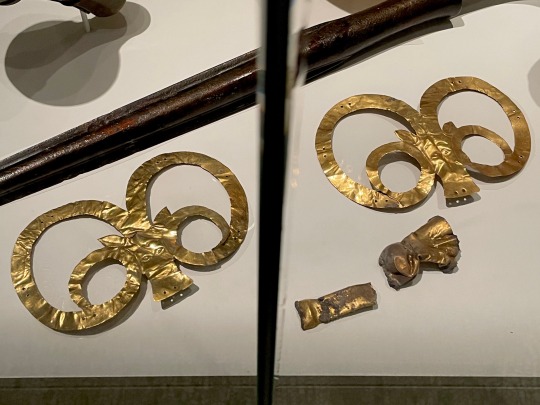
1. garment decorations, Tepe Hissar (Iran), c. 2300 BCE, gold.
“These striking gold appliques in the shape of a ram's head would have been secured to clothing through the holes pierced around their edge.”
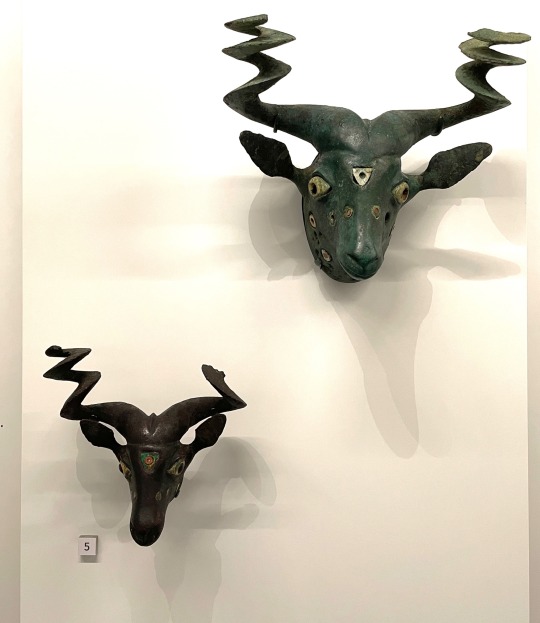
2. goat heads, possibly Fara (Iraq), c. 2475-2300 BCE, copper alloy, shell, limestone.
“These heads were cast in copper and inlaid with shell and colored limestone. The powerful corkscrew horns capture the majesty of a wild markhor mountain goats.”
#Two for Tuesday#Penn Museum#museum visit#pairs#ram#goat#markhor#decorative arts#historical costume#precious metals#gold#copper#sculpture#ancient art#Middle Eastern art#animals in art
19 notes
·
View notes
Text
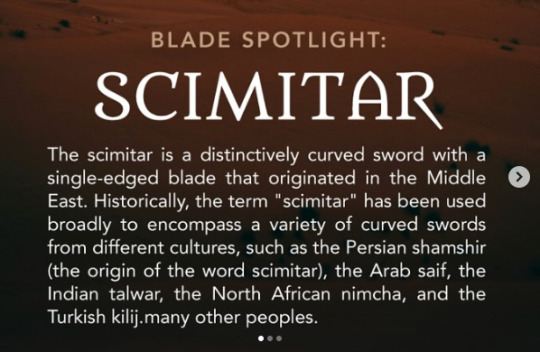
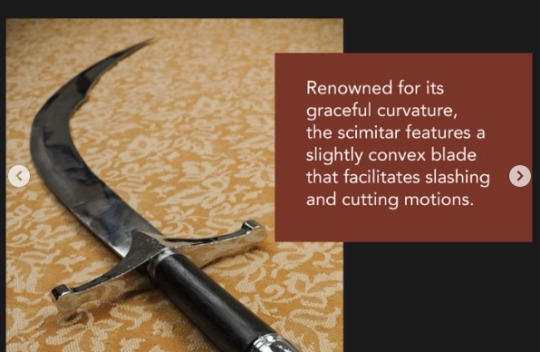
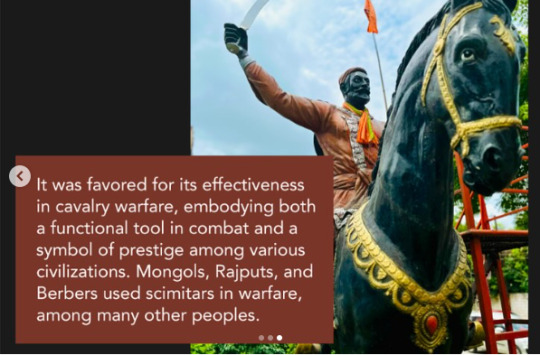
Embrace the elegance of the scimitar! This distinctively curved sword with a single-edged blade has a rich history originating in the Middle East. From the Persian shamshir to the Indian talwar, the scimitar has been embraced by various cultures. Discover the beauty and power of this iconic weapon at Kultofathena.com.
#Kult of Athena#KultofAthena#WorldOfKOA#sword#swords#weapon#weapons#blade#blades#Scimitar#Middle Eastern Indian & N. African Swords#Middle Eastern Indian & N. African Weapons#Belly Dance Swords#Battle Ready#Decorative
0 notes
Text
It just occurred to me today, that I've never seen a kebab place or any middle-eastern restaurant decorated for any particular muslim holiday or celebration. I could see it maybe being a cultural thing - like maybe that kind of things are considered private and celebrated at home with family and are not for the eyes of snooping customers - but I know enough of my own background to be pretty sure that if a christian who was born and raised in a christian land had to move somewhere else to run a business, they would probably like setting up a little decorated tree or christmas lights around there for december. And I would find it terribly sad if they wouldn't.
281 notes
·
View notes
Text
April 13, Xi'an, China, Shaanxi Archaeology Museum/陕西考古博物馆 (Part 4 - Sui and Tang dynasties):
This is another star of the museum, a Tang dynasty (618 - 907 AD) bronze mirror, the back of which is decorated with carved luodian/螺钿 (mother of pearl). Near the edge are various birds, while the inner ring is arranged in a "sunflower" shape. Kinda wish I can see a modern replica of this one without all these marks and discolorations from the passage of time:

A Tang dynasty yupei/玉佩 (jade pendant). Unlike the Western Zhou dynasty yupei in part 2, this type is most definitely supposed to be hung from the waist. This one in particular was one of a set of two (both worn on waist, one on each side), and these were part of the formal wear of first to fifth rank officials during Tang dynasty:

Luo Wanshun's Epitaph/罗婉顺墓志. As mentioned in the first Beilin museum post, ancient Chinese epitaphs have a two-piece structure, consisting of a tablet and the protective covering on top. This is the protective covering on top, with the large inscription identifying this as the epitaph stone of Luo Wanshun, engraved in seal script/zhuanshu/篆书:

And here's the actual body of the epitaph. This particular epitaph was drafted by one of the "Eight Immortals of the Wine Cup"/饮中八仙, Li Jin/李琎 (he was also the nephew of Emperor Xuanzong of Tang/唐玄宗), and the calligraphy was provided by the famous calligrapher Yan Zhenqing/颜真卿:

Tang-era pottery figurines of the Chinese zodiac animals. This set is sadly incomplete, but the way these zodiac animals are partially anthropomorphized is pretty interesting. From left to right, these are tiger, rabbit, dragon, snake, sheep, and dog (yep that is a dog head, apparently). Not sure why rabbit and dog figurines are missing their ears though, maybe the ears broke off and are lost?

Sui dynasty (581 - 618 AD) green-glazed boshanlu/博山炉 incense burner. Note the panlong/蟠龙 dragon curled around the base:

Left: Sui dynasty white-glazed ewer with a chicken head-shaped handle. Right: Sui dynasty white-glazed vase. The curves on this one is *chef kiss*

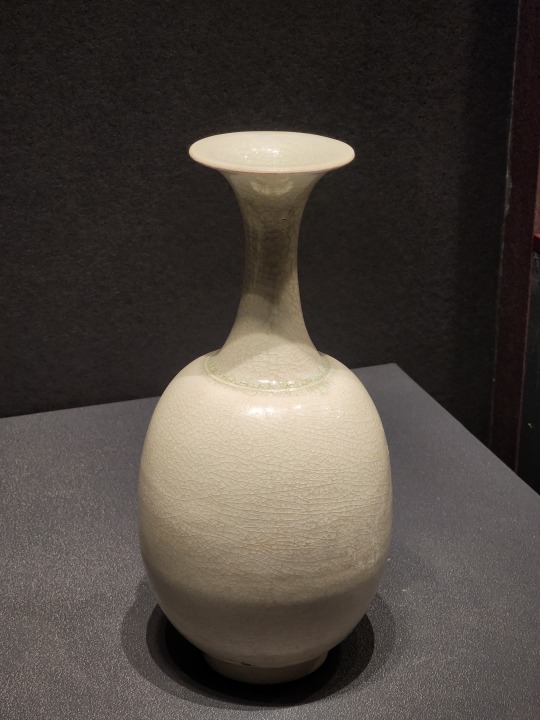
More Sui dynasty white glazed pottery, but the most incredible thing is the white porcelain cup in the middle. The lip of that cup is 1mm (~1/32 in) thick, and the sides are so thin, it's almost see through:

Tang-era sancai/三彩 glazed conjoined flasks that is shaped like a pair of fish. Similar twin-fish motif can be found in numerous traditional Chinese holiday decor, and symbolize auspiciousness, wealth, and surplus--especially surplus, since fish in Chinese (鱼) is pronounced yú, and "surplus" in Chinese (余) is also pronounced yú. This is why the phrase 年年有余 ("may there be a surplus every year") is often paired up with imagery of carps, children holding giant carps, or a twin-fish motif.
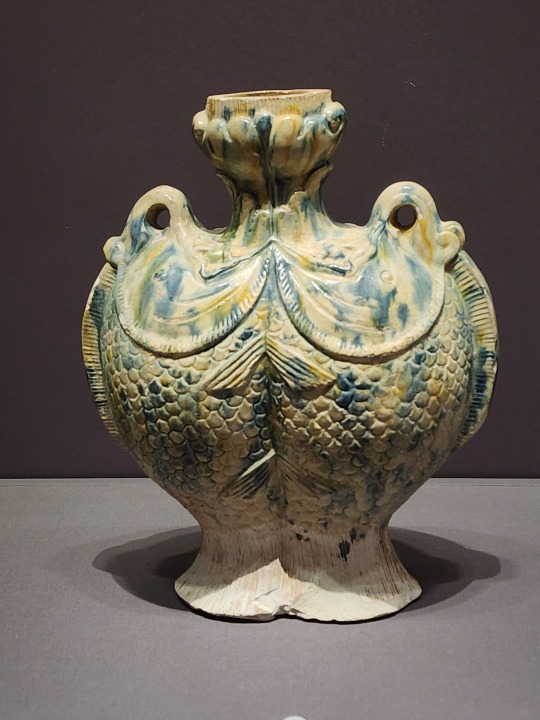
Absolutely beautiful Tang-era wall mural of a tiger, which was very sadly damaged over time. But from the pieces left, you can still appreciate the raw power of the tiger captured by these lines:

Another beautiful Tang-era wall mural depicting men on horseback playing "polo", called maqiu/马球 (lit. "horse ball") in Chinese. It's unclear whether the maqiu depicted here originated in China in late Eastern Han dynasty (25 - 220 AD) or was brought to China via the Silk Road at the beginning of Tang dynasty, but anyway this sport was very popular during Tang dynasty, and there were many female players at the time too.
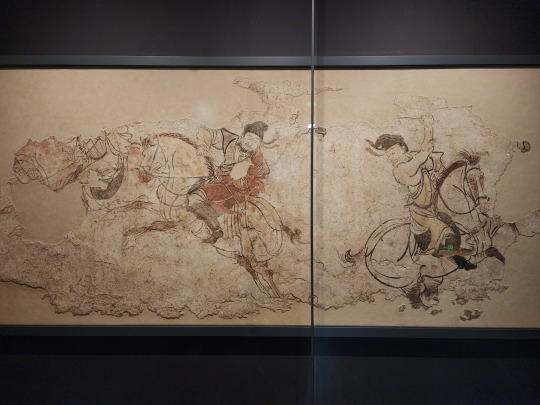
The women of Tang dynasty as depicted by pottery figurines:


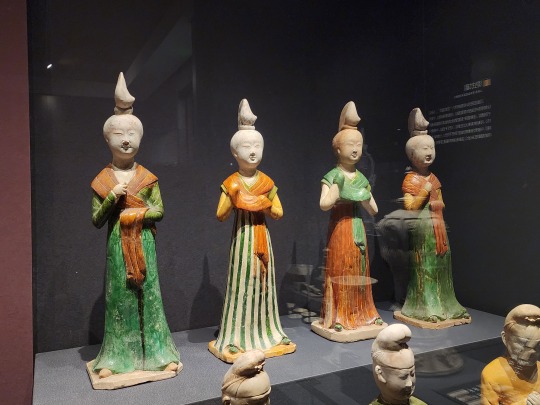

A small model of Tang-era triple que/阙 gate towers. Que gate towers first appeared in Western Zhou dynasty (1046 - 771 BC) and have been a part of Chinese architecture ever since. Que gate towers usually come in pairs, one on each side of the gate, and they were used to display status.

A map of Tang dynasty Chang'an city laid on top of the current map of Xi'an city, showing the imperial palace (top center), the East Market/东市 and West Market/西市, and the 108 districts (called fang/坊):

A Tang-era chiwen/鸱吻 (螭吻 is the original name, 鸱吻 is the alternative name, another alternative name is 蚩吻, but the pronunciation remains the same for all three) roof ornament. These are the pairs of horn-shaped pieces on the top of the roof of traditional Chinese architecture. These ornaments are made to represent the Ninth Son of the Dragon, called Chiwen/螭吻, which looks like a dragon-headed fish and has the power to control water, thus it's used in traditional Chinese architecture to ward off fires:
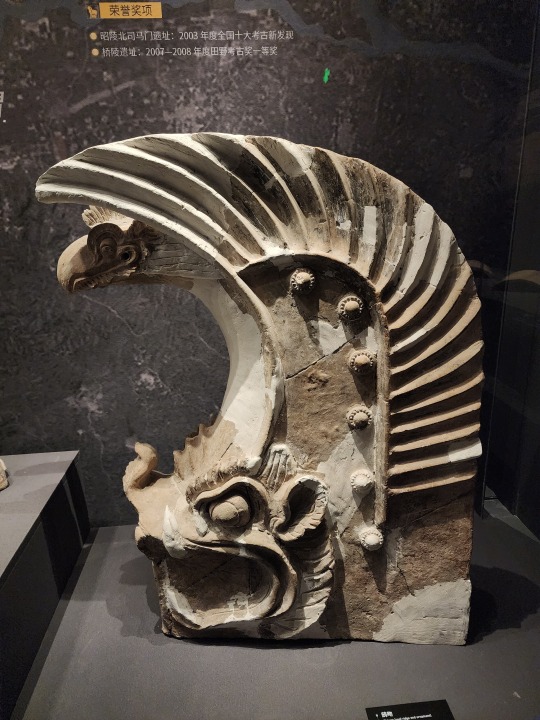
Sui-era gold gilded handle of a stone sarcophagus:

A pottery jar found buried in the tomb of Crown Prince Jiemin/节愍太子 (Li Chongjun/李重俊, son of Emperor Zhongzong of Tang/唐中宗 Li Xian/李显), partially shaped like a pagoda and decorated with various Buddhist motifs such as lotus petals and elephant heads. This is speculated to be a representation of a granary, which would hold grains for the crown prince in the afterlife:
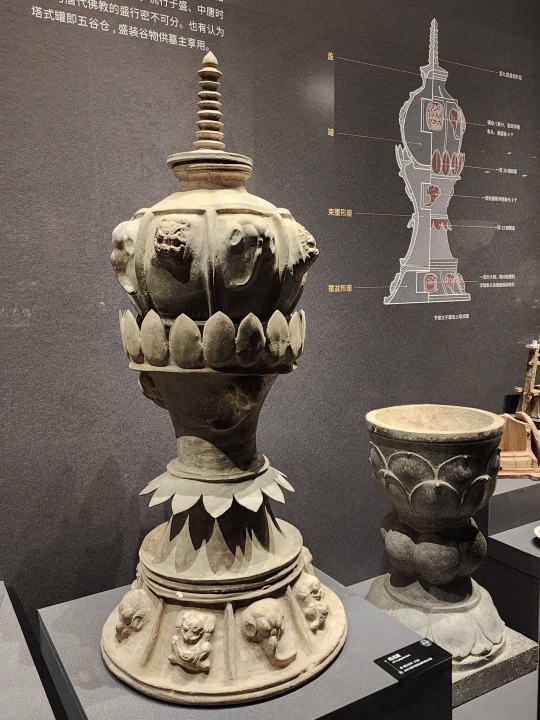
And last but not least, a Sui-era pottery camel bearing sacks that have the imagery of the Greek god of wine Dionysus upon them, which shows the great amount of cultural exchange that took place back then:

#2024 china#xi'an#china#shaanxi archaeology museum#chinese history#chinese culture#sui dynasty#tang dynasty#chinese calligraphy#calligraphy#archaeology#history#culture
244 notes
·
View notes
Text






LUDWIG DEUTSCH - THE PALACE GUARD, 1892
The painting depicts a palace guard standing in an ornate, richly decorated setting typical of Middle Eastern or North African architecture. He is dressed in traditional attire that includes a yellow cloak draped over his shoulder, a chainmail shirt, and a blue skirt-like garment. The guard holds a long spear with a decorative top, which leans against the wall beside him.The background features detailed tile work with geometric patterns and an archway, indicative of Islamic architectural influence. At the guard's feet, there are a pair of red shoes, which might indicate that he has removed them out of respect for the sacred space he's guarding.
Deutsch's multiple trips to Egypt provided him with firsthand exposure to the culture, architecture, and daily life of the region. His visits allowed him to gather authentic visual references, which were crucial for the detailed and accurate depiction of this masterpiece. The guard's attire, the architectural setting, and cultural nuances like the removal of shoes are direct results of his observations during these travels.
By 1893, Deutsch was at the height of his career. His works were being regularly exhibited in prestigious salons in Paris, where he had moved in 1870. This period was one of recognition and success, with his detailed and exotic depictions gaining popularity among collectors and the public. Critics appreciated the meticulous depiction of textures, fabrics, and architectural elements, which showcased his mastery of the medium. His ability to capture the essence of the exotic and romanticized East was also praised.
62 notes
·
View notes
Photo

Minoan Civilization
The Minoan Civilization flourished in the Middle Bronze Age (c. 2000 - c. 1450 BCE) on the island of Crete located in the eastern Mediterranean. With their unique art and architecture, and the spread of their ideas through contact with other cultures across the Aegean, the Minoans made a significant contribution to the development of Western European civilization.
Labyrinth-like palace complexes, vivid frescoes depicting scenes such as bull-leaping and processions, fine gold jewellery, elegant stone vases, and pottery with vibrant decorations of marine life are all particular features of Minoan Crete.
Arthur Evans & Discovery
The archaeologist Sir Arthur Evans was first alerted to the possible presence of an ancient civilization on Crete by surviving carved seal stones worn as charms by native Cretans in the early 20th century CE. Excavating at Knossos from 1900 to 1905 CE, Evans discovered extensive ruins which confirmed the ancient accounts, both literary and mythological, of a sophisticated Cretan culture and possible site of the legendary labyrinth and palace of King Minos. It was Evans who coined the term Minoan in reference to this legendary Bronze Age king. Evans, seeing what he believed to be the growth and decline of a unified culture on Crete, divided the island's Bronze Age into three distinct phases largely based on different pottery styles:
Early Bronze Age or Early Minoan (EM): 3000-2100 BCE
Middle Bronze Age or Middle Minoan (MM): 2100-1600 BCE
Late Bronze Age or Late Minoan (LM): 1600-1100 BCE
The above divisions were subsequently refined by adding numbered subphases to each group (e.g. MM II). Radio-carbon dating and tree-ring calibration techniques have helped to further refine the dates so that the Early Bronze Age now begins c. 3500 BCE and the Late Bronze Age c. 1700 BCE. An alternative to this series of divisions, created by Platon, instead focuses on the events occurring in and around the major Minoan “palaces”. This scheme has four periods:
Prepalatial: 3000 - 2000/1900 BCE
Protopalatial: 2000/1900 - 1700 BCE
Neopalatial: 1700 - 1470/1450 BCE
Postpalatial: 1470/1450 - 1100 BCE
Both of these schemes have since been challenged by more modern archaeology and approaches to history and anthropology in general which prefer a more multilinear development of culture on Crete with a more complex scenario involving conflicts and inequalities between settlements and which also considers their cultural differences as well as their obvious similarities.
Continue reading...
97 notes
·
View notes
Text
A Love Connection: Holiday Reunion Special
Hello and welcome to my Christmas AUvent Calendar! Every day from now until the 24th I will be posting a ficlet that is 500-1500 from an AU I've done over the years.
All stories will be marked with the tag #12 aus of christmas so you can follow along as I will only be tagging my permanent list for this (it would get too confusing otherwise).
The next one on our list is: Game Show verse. You can read the story here. All links will be to the first chapter, but the chapter itself will have links to the rest of the story.
Day 1 Day 2 Day 3 Day 4 Day 5 Day 6 Day 7
~
“Welcome back to A Love Connection! It’s our Christmas reunion special where we get together our greatest successes and follow them around for Christmas and catch up with them for the holidays! I’m your host Bob Newby and I’m pleased to announce our four couples!”
The audience clapped, cheered, and whistled.
“First we have Leslie and Scott Clark from season six!” Bob said with a smile. “They are our longest lasting couple to date! Scott is a middle school science teacher who also heads the AV and Communications Club. Leslie is a neonatal nurse who specializes in premmies! They’ve been together for the last eight years!”
On the first loveseat which was bright white was a lovely older couple. He was lean and wore glasses with a bright smile, while Leslie was an Asian woman, whose smile was small but genuine.
The crowd cheered for them and they waved at the camera.
“Then we have Abel and Maria Johnson from season ten,” Bob continued. “Abel owns his own Americana restaurant and Maria quit her job as a police officer to be a stay at home mom two their two kids, Enrique aged two and Kelly aged four months.”
Abel was a large and happy man with a goatee and thinning black hair. Maria was a latina with a pinched expression as she seemed to be pulling away from Abel’s arm around her shoulder.
The crowd cheered for them and while Abel waved, Maria gave the camera a paltry smile.
“Next we have Abdul and Nadia Rafiq, from season twelve,” Bob said with a smile. “Who have decided this year to celebrate Christmas as friend holiday instead of a religious one and have graciously allowed us to follow them on their journey. Abdul is an electrical engineer for the US army, while Nadia is a game designer. They are expecting their first child next summer!”
They were both a lovely couple of Middle Eastern decent and she only had eyes for him and while he appeared to be ignoring her, he was playing with her earring.
The crowd cheered and whistled, making Abdul nod with a small smile and Nadia to wave excitedly at the camera.
“And finally,” Bob said, “the sweethearts of season thirteen, the lovely and adorable, Eddie Munson and Steve Harrington. Steve is another middle school teacher, they must have all the luck.” The crowd laughed. “He teaches history and coaches basketball. Eddie is a music producer and former frontman of Corroded Coffin.”
Steve and Eddie wave at the camera and the crowd is even louder for them than anyone else.
“For Scott and Leslie,” Bob said, “we followed them around the chaos that Christmas when your schedules are so misaligned. Let’s watch.”
The video showed stolen moments of kisses under a mistletoe, late night decorating the tree, and early morning wrapping presents. Their video ended with Scott and his communication club bringing Christmas dinner to neonatal ward.
The audience cooed and clapped.
“For Abel and Maria,” Bob said, “we followed them around getting Christmas ready for their two kids with Abel having long hours from the restaurant.”
The video had tried to show the best bits. They really did, but everyone could tell that it was all very strained. Maria seemed to be doing all the work, while Abel got all the credit. Steve was sure that by New Year’s Maria was going to divorce Abel’s ass.
The video ended with the two of them kissing under the twinkling lights of their house Christmas decorations.
The audience clapped, but it felt forced and awkward to Steve.
“For Abdul and Nadia,” Bob said with a gentle smile, “they had a couple of friends who helped them navigate forming their own traditions for the day.”
Their video showed a nice black couple helping the two of them pick things they liked about the new to them holiday. Abdul picked a Christmas tree and one gift opened on Christmas eve, while Nadia loved the idea of stockings hung over the fireplace and matching pajamas.
It was lovely, though it was clear they were out of their depth.
“For Steve and Eddie,” Bob concluded, “we have Eddie putting on a very special music program for Steve’s school.”
The video showed Steve working tirelessly with the music and choir teachers until the night arrived. Then instead of the band and orchestra teacher conducting, Eddie stepped out and the crowd went wild. All the kids were freaking out and a good number of the parents too. The concert was a rousing success and a lot of money was raised for the music programs for the school.
The audience laughed and cheered their way through the video.
“That was adorable,” Bob said. “But that’s the sort of thing we expect from Steve and Eddie.”
Bob chatted with each of the couples and each one signed off, wishing the viewers a Merry Christmas. With Maria wishing them a feliz navidad and Abdul and Nadia wishing them an eid milad majid.
Bob came up to them after. “Thanks for coming out. It’s getting harder and harder every year to find our success stories, but I think I’m most proudest of yours.”
Steve and Eddie blushed.
“Thank you,” Steve murmured.
“I think there are going to be a great many more happy Christmases in the future.”
Bob gave each of their shoulders a squeeze. “Then this show will have done something right.”
He wished them a happy holiday and bid them goodbye.
“Merry Christmas, Stevie,” Eddie murmured coming in for a kiss.
“Merry Christmas, Eds.”
~
Day 9 Day 10 Day 11 Day 12
Tag List: CLOSED
1- @itsall-taken @redfreckledwolf @zerokrox-blog @sadisticaltarts @dolphincliffs
2- @gregre369 @a-little-unsteddie @chaosgremlinmunson @cryptid-system @kultiras
3- @maya-custodios-dionach @goodolefashionedloverboi @val-from-lawrence @carlyv @wonderland-girl143-blog
4- @bookbinderbitch @bookworm0690 @forgottenkanji @dreamercec @blondie1006
5- @yikes-a-bee @awkwardgravity1 @genderless-spoon @fearieshadow @thesecondfate
6- @dragonmama76 @ellietheasexylibrarian @thedragonsaunt @useless-nb-bisexual @disrespectedgoatman
7- @counting-dollars-counting-stars @tinyplanet95 @ravenfrog @swimmingbirdrunningrock @lingeringmirth
8- @gutterflower77 @a-lovely-craziness @just-a-tiny-void @w1ll0wtr33 @beelze-the-bubkiss
56 notes
·
View notes
Text

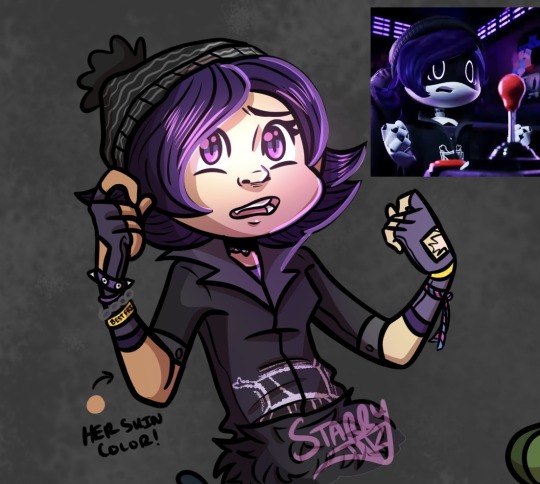




[CLICK FOR BETTER QUALITY]
[Likes and Reblogs are appreciated!]
Hey guys!!! I said I would work on a Uzi human version to match with my N human version, so here it is!!! I decided to make her a mix of Japanese and Middle Eastern, since Nori means seaweed in Japanese and I’ve have a friend named Khan who was Middle Eastern irl!
Since you guys like the headcannons last time, have some about Uzi:
Uzi was born with blue eyes and black hair, like her parents had, though Khans eyes were a more icy blue. When Khan started to neglect Uzi, she decided to mimick the appearance of her mother instead, seeing her as a role model after everything cool she heard about her around the colony, dying her hair purple like her.
In this AU, Uzi knew her mother before she died for a short time as an infant. Of course, she doesn’t remember much, but she does remember the play dates she used to have with her cousin Doll anytime her aunt Yeva would come over.
Nori and Yeva were sisters, both genetically modified to have the solver inside of them, making Doll and Uzi cousins. Nori and Yeva knew the consequences of having offspring with the solver in their veins but were actively working on a cure before Noris demise.
Uzi, Doll, Lizzy and Thad used to be childhood friends, but after Nori died and Yeva began to pull Doll away from her cousin to protect her from any trace of the solver, Doll and Lizzy began to bully Uzi.
Uzi came out short, like her father Khan, whereas Nori was tall, partially due to the effects of the solver.
Uzi's favorite foods are Philadelphia Sushi Rolls, Shrimp Tempura Rolls, Shoyu Ramen, and Khan Plov (suprisingly)
Uzi's favorite dessert is Apple Cheesecake!
Khan and Uzi used to have a pretty wholesome father daughter bond, but when Nori passed, he distanced himself from his daughter around the time Doll and Lizzy started bullying her, due to fear the solver may have developed in his daughter. Unfortunately we all know what eventually happens in the series and how Khan picked the worst time in her life to try and rekindle a bond with her.
Uzi has a scar on her left shoulder from N stabbing her with his wing in the Pilot, but honestly she doesn't care if people see it, unlike N who's self concious about his scars, and she thinks it looks cool.
Once she begins to be taken over by the solver, her thirst for oil is uncontrollable, though she HATES the taste of it.
Uzi's favorite anime is Chainsaw Man, though N thinks it's to gorey.
N taught Uzi to fly with her wings, and it went...as well as you could expect the first few times, but eventually she learned.
Sometimes Uzi has moments where she doesn't remember certain events in the day like what she ate for breakfeast or what she did that day in school, and her mind sort of blips all over the place ever since her solver powers were activated. She doesn't know this, but whenever that happens the solver is slowly getting acustomed to her body, putting her conciousness to "rest" while it tries out her body.
N and Uzi's favorite activity is to watch the sun rise together from inside an abandoned building they have made their "treehouse" of sorts. V doesn't know about it, and it's filled to the brim with comfort items, furniture and decorations for whenever they decide to stay out too late and no make it back home to risk burning up.
Uzi's favorite animal is cows!
Uzi and N spoon each other often, even when they were just friends, because the warmth of their bodies makes them feel safe and loved.
Uzi's favorite subject is Science and anything to do with being hands on. She likes learning and school, but just "dislikes" likes and doesn't know how to speak to them without being bullied her peers with a passion.
Uzi can be very motherly and protective, and is actually very nuturing and kind underneath her edginess.
She'll NEVER tell V this to her face, but she's grown to love V as a big sister of sorts and cares about her as much as N.
Her favorite color purple. She thinks it makes her and N match look cool but you didnt hear that from her.
She likes alot of metal and hardstyle types of music, but acutally enjoy's N's upbeat and pop music from the late 1900's and early 2000's human era more than she lets on.
She doesn't like when N uses his deeper voice and whispers in her ear...it makes her feel...weird. But in a good way- wait what?
She loves to draw and totally doesn't have sketches of her, N and V as superhero anime characters, her and N building a neural network together in her sketchbook. EW. GROSS.
>> PS. This is part of my Murder Drones Skin and Bones AU!
I didn't know how to end this, but I will say Im totally doing the other characters! Next is V!
____________________________________________________________
ALSOOOOO…

THANKYOU ALL FOR 1,000 FOLLOWERS GUYS!!!
IM WORKING ON A BUNCH OF STUFF LIKE ANIMATIONS ON YOUTUBE, MORE AU THINGS, AND WORKING ON MY ABSOLUTELY FANFIC! I'm hoping to expand more on my comics on Tumblr like my @thedarknessyouhold and the Murder Drones universe as a whole, so stick around for some awesome stuff coming soon!
My commisions are also open! You can find them on my KO-FI HERE and HERE !
You can ALSO find updates and sneak peeks sometimes as well!
AND my LINKTREE HERE!
#murder drones#murder drones fanart#murder drones uzi#uzi md#md uzi#digital art#fan art#starryinkartwork#mdsab
206 notes
·
View notes
Text
this little worm has wiggled its way into my mind and won’t leave 😵💫 part 2
imagine a young keegan russ, maybe around 17/18?, whose enrolment in military school has relocated him to a whole new state. he’s got a few dollars in his back pocket, but not enough to buy him the nice pillows or blankets in the tuck shop.
so he gets a job.
it’s in some restaurant, one that does large portions of foreign food that smell delightful. greek, maybe? definitely middle eastern, though. most of the workers have a light brown complexion with dark hair and thick brows, long noses and plump lips. he stands out like a sore thumb.
but with his tight, military schedule, he can only do a few hours here and there. which the restaurant don’t mind, it seems this town is full of floundering military school kids. so they put him in charge of the juice bar.
keegan feels a bit stupid stood among the shiny, fake fruit decor and creased hanging vines. but he just reminds himself of the good pay he’s getting for putting in these pathetic hours. he follows the recipes, gets through the day, picks up his pay packet.
rinse and repeat.
you were the first waitress to talk to him, and god did you take his breath away. you had skipped up to his bar, a crumpled, little notepad clutched in your hand and pen tucked behind your ear in a dorky way, but he found it cute.
“hey! you’re new, right?” your voice was like gentle heaven on his ears.
“um, yeah. I am.” internally, he was ripping his vocal cords out and cursing himself for sounding so awkward. but he remained emotionless on the outside. “keegan.”
“y/n, it’s nice to have someone new around,” your smile melted his heart and his mind, butterflies erupting in his rising stomach.
“yeah… it’s nice to be somewhere new…”
should I continue this?
#x reader#call of duty#call of duty x you#call of duty x reader#keegan x reader#keegan p russ#cod keegan#keegan x you#keegan russ x reader#keegan russ x you#cod au#call of duty restaurant au#restaurant au#call of duty au#call of duty keegan#keegan
127 notes
·
View notes
Note
How do you imagine Queen Daenerys style evolution to be? From Essosi influences to slowly accomodate or create a new style?
my real life daughter

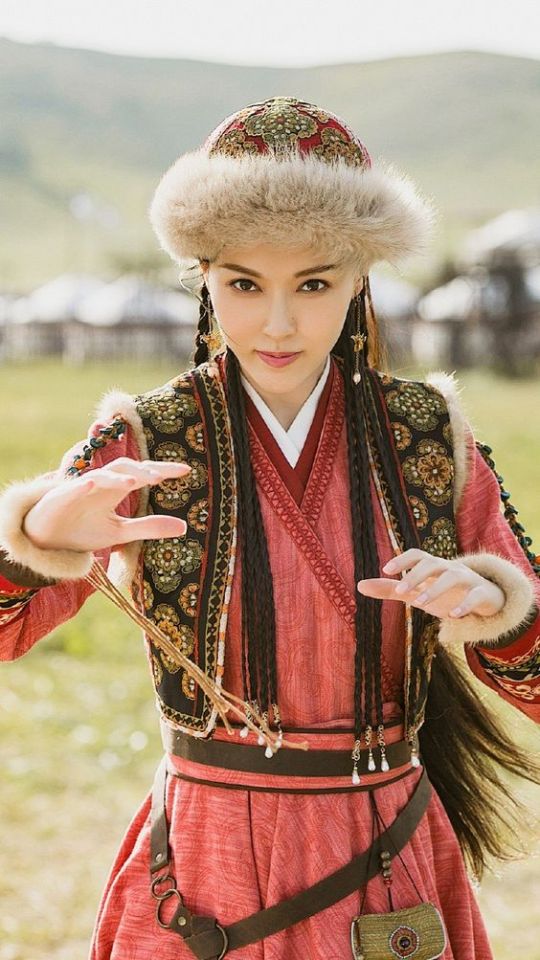
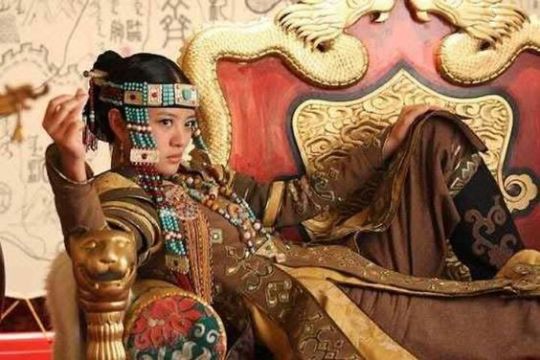
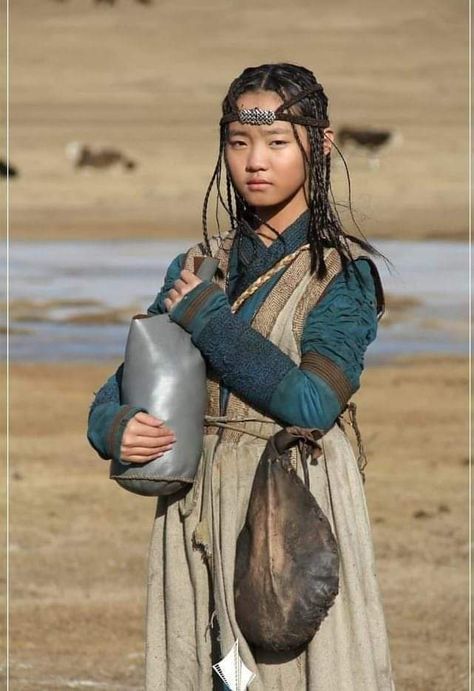
I don't think Dany grew up with a particular style, due to being on the run and just wearing whatever she was given by her current host. But when she gets married, she has to wear the Mongolian-inspired garb I headcanon for the Dothraki. For ceremonies and formal gatherings, she wears a heavy and embroidered gown that's hard to move in, along with a horse hair headdress that makes her neck hurt. For more casual days, she wears comfortable leather pants and cotton wrapped robes, finely crafted for her status as Khaleesi. Once Drogo dies and she goes on the worst roadtrip of all time, her once fine clothing has deteriorated to filthy rags in the Red Wastes' heat.
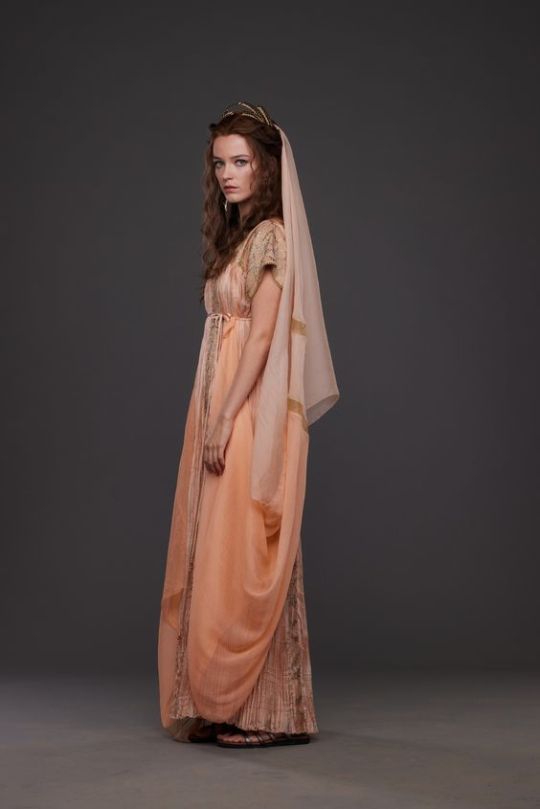
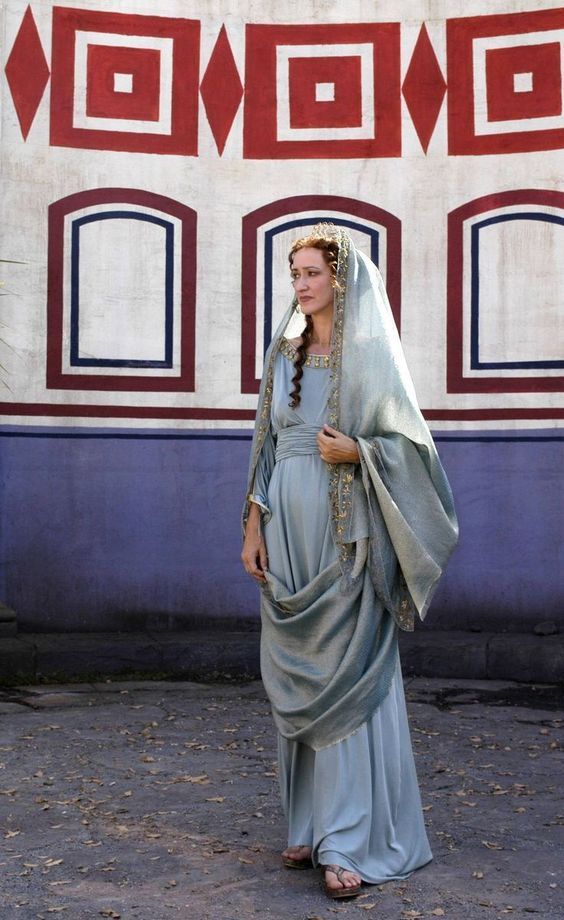
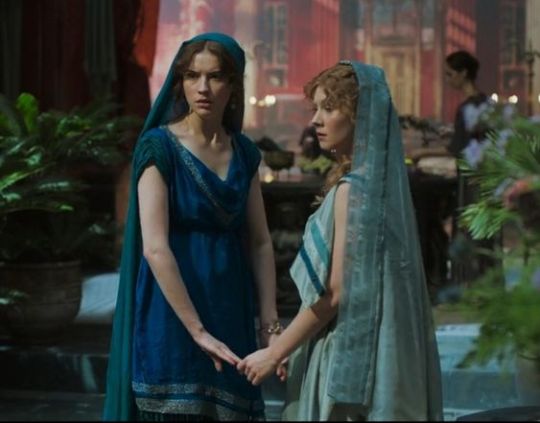

Dany's Qarth fashions are once again her being dressed up by whoever her host is, with no real identity through her clothing. Hm this might be an ongoing theme. My late Roman Republic inspired Qarth how I love you. Long, loose, simply shaped gowns made of thinner material that kept the heat out and a breeze flowing. Delicate crowns and headpieces, with long veils she drapes around her shoulders and waist. So so so many colors and different patterns that keep Dany feeling like a peacock as she is paraded around.
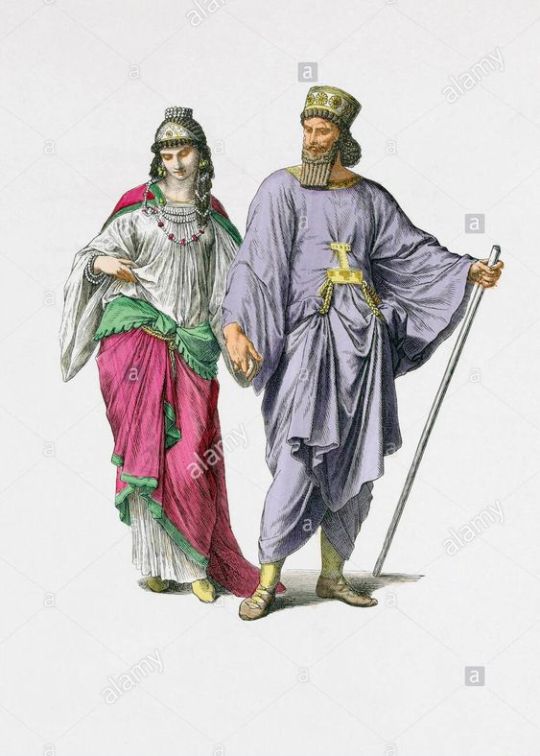
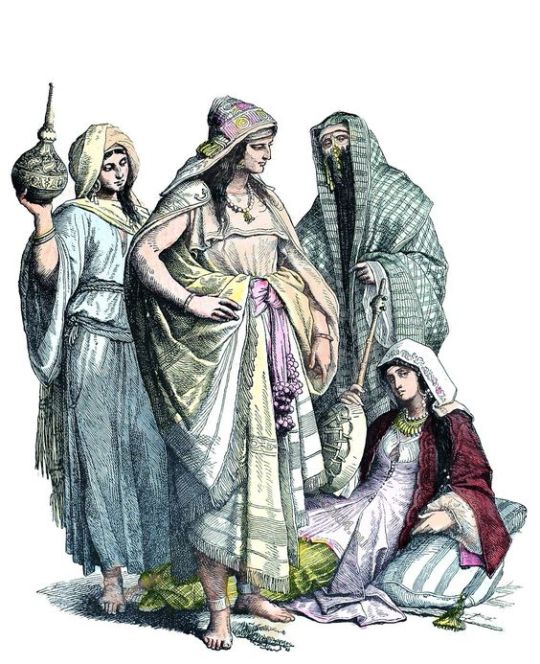
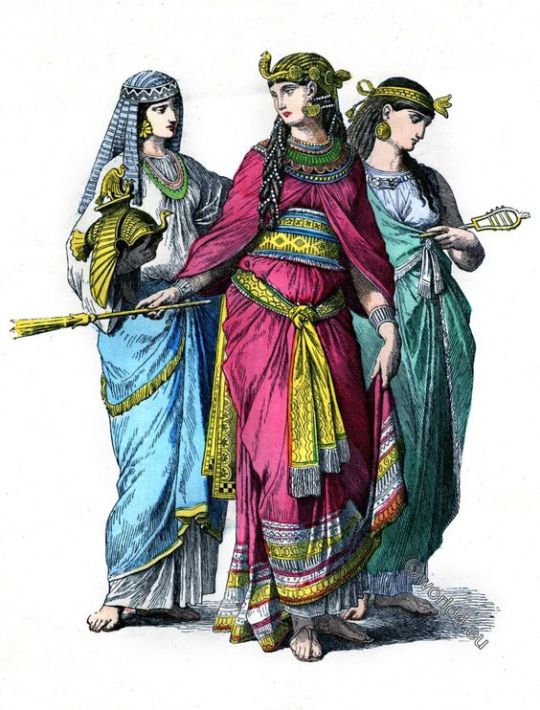
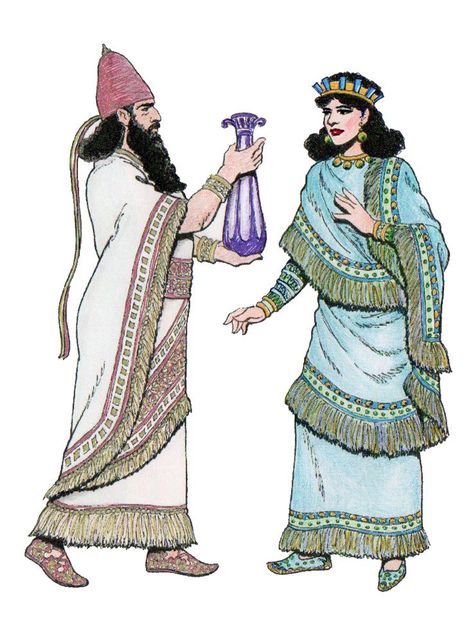
Unfortunately I have lots of ideas about the slaver cities and their clothing, but they include the blending of multiple real life cultures, so there are no actual costumes to go off of, just cool art that I hope u mush together in ur mind :] But for Dany's arrival at Astapor, Yunkai, and Mereen, I think about a combination of ancient middle eastern cultures like Babylonia, Assyria, and ancient Egypt (though I am unfortunately not as well versed in their clothing histories as some other cultures). Dress here is far more complex than in Qarth, with multiple gowns and pieces of clothing wrapped around and tucked into one another, with decorated belts and fringed draperies and heavy jewelry. Dany often feels like she's drowning in it, but is determined to absorb herself into their culture.
And cut to if we ever get Winds and Dany sails for Westeros wearing a combination of the styles she has worn over the years, leather pants and linen tunics and short wrapped gowns, as an accumulation of everything she's learned, but this time she is confident and sure of herself :] though that's just a pipe dream George please release wi
#asoiaf hair and clothing#I have sooooo many thots ab Dany fashion unfortunately its hard to find what I want on the Internet#I should do more digging and re-up this later with more accurate ideas bc I feel like im not doing my bbygirl justice
74 notes
·
View notes
Text
Across the Street | CC-Free Sims 2 Lot | Create-a-town
Here is the next lot in my series of small-town community buildings for your game. These lots are unique from a lot of user-created content that you can find out there because they are designed for decorators to have fun with. They are unfinished on purpose. 😊

This set of shops has a lot of visual diversity that will fit in in just about any small-town. Like the previous lot in the series, some of these shops are lightly furnished downstairs, but most are empty upstairs. This is done on purpose to give you the enjoyment of changing things up and decorating them to your heart’s content! 🥰

Since things are kind of hard to see in the main image, here are a few pictures of the shops. I’ve put some suggested use titles on them, but you are welcome to change them up. These are all built on the same lot.
Small grocery store:

Cozy “hole in the wall” restaurant:

Appliance or computer shop:

Middle-eastern restaurant:

Spa/hair salon:

Consulting/Legal offices, and bus stop:

Here’s the floor layout so you can see what you’ve got to work with:
1st floor:

2nd floor: The podium in the building to the far right is a career reward. You can download a mod that makes them buyable over at MTS. It is not included in this file.

Basement: Yes, this lot has a basement for storage too! Only one set of stairs go down to it though since the lot is pretty narrow front to back.

Across the Street: MF | STS
CC-Free, but all EPs and SPs are required.
I’ve run this lot through the Lot Compressor so any random references to sims that aren’t there should be removed. I have also run it through the Lot Cleaner to remove any bits of buggy code. This lot comes with a shiny custom thumbnail so it has even more curb appeal in your Lots and Houses bin! 😄
I ALWAYS recommend using the Sims 2 Pack Clean installer to install lot files.
The rest of the shops in this series: Main Street Shops The Next Street Over Around the Corner Further Down the Street At the Office Small Shopping Center
#kirlicuessimlots#create-a-town lots#cc-free lot download#community lot#nocc#ts2#ts2 cc#sims2#s2build#ts2 build#sims 2 lot#sims 2 lots#lot download#sims 2 house#ts2 screenshots#sims 2 build#ts2 download#sims 2 download#the sims 2#thesims2#lot
36 notes
·
View notes
Text

Missing Pieces of 6th-Century Byzantine Bucket Finally Found at Sutton Hoo
While working at the Anglo-Saxon site of Sutton Hoo in England, archaeologists found the missing pieces of a 1,500-year-old copper bucket imported from Turkey. The bucket, which is at least a century older than the famed ship burial, may provide a window into how people lived in early medieval times.
A team of archaeologists, conservators and volunteers from Time Team, the U.K.'s National Trust and FAS Heritage discovered the metal fragments in late June during excavation and metal-detecting work at Sutton Hoo.
Sutton Hoo is best known for its magnificent seventh-century ship burial, whose 1939 discovery was featured in the 2021 movie "The Dig." But the burial was just one part of a complex of 18 separate burial mounds found near Suffolk in southeastern England, many of which contained jewelry and coins. Evidence of imported goods — including an Egyptian bowl, Eastern Mediterranean silverware and a Middle Eastern petroleum product called bitumen — has also been discovered at Sutton Hoo.
But the copper-alloy bucket, known as the Bromeswell Bucket, predates the ship burial by at least a century. The fragmented bucket, which was found in 1986, depicts a North African hunting scene featuring lions and a dog. It was likely produced in the sixth century in Antioch, Turkey, which was then part of the Byzantine Empire. An inscription in Greek on the bucket reads, "Use this in good health, Master Count, for many happy years," suggesting that it may have been a diplomatic gift.
The artifacts uncovered last month were decorated with figures similar to those on the original find. So the team employed X-ray fluorescence (XRF) — which is used to determine which elements are present in an object and to create a unique elemental "fingerprint" of the artifact — to confirm that the newly recovered fragments are indeed part of the sixth-century Bromeswell Bucket.
"Thanks to closer inspection, we now believe that the bucket had been previously damaged and then repaired," Angus Wainwright, a regional archaeologist in the East of England for the National Trust, said in a statement. "In-depth analysis of the metals suggests it might even have been soldered back together."
Although East Anglia has been occupied since at least 3000 B.C., when Sutton Hoo was in use as a cemetery in the sixth and seventh centuries, the area was relatively densely populated and part of a busy trade network. The Sutton Hoo treasures represent diverse objects, including pagan and Christian artifacts, brought there from all over Europe and the Middle East. The ship burial and cosmopolitan nature of Sutton Hoo may even link it to the Old English epic poem Beowulf, which includes tales of gift-bestowing kings from far-flung lands and was composed around the same time.
"It's hoped that this two-year research project will help us learn more about the wider landscape at Sutton Hoo and the everyday lives of the people that lived there," Wainwright said. "So, this find is a great step on that journey."
By Kristina Killgrove.


#Missing Pieces of 6th-Century Byzantine Bucket Finally Found at Sutton Hoo#Sutton Hoo in England#Bromeswell Bucket#ancient artifacts#archeology#archeolgst#history#history news#ancient history#ancient culture#ancient civilizations#byzantine empire#ancient art
69 notes
·
View notes
Text
April 13, Xi'an, China, Shaanxi Archaeology Museum/陕西考古博物馆 (Part 3 - Qin dynasty to Sui dynasty):
First up is one of many bronze edict tablets of the 2nd emperor of Qin dynasty, made in 209 BC. Inscribed upon it in Seal script is one of two edicts, specifically the one from the 2nd emperor of Qin dynasty (秦二世), which basically is a continuation of Qin Shi Huang's edict on standardizing all weights and measurements. Here Qin Shi Huang/秦始皇 is referred to as Shi Huangdi/始皇帝, where shi/始 means "origin", and huangdi/皇帝 means "emperor".

^The edict inscribed is as follows (this is my VERY rough translation, please take this with a grain of salt, I'm not great at reading Old Chinese; original text is on bottom right of picture):
“First year (209 BC; first year of 2nd Emperor of Qin's reign), [We] issued an edict to chancellors Li Si and Feng Quji: Shi Huangdi pioneered this effort to standardize all weights and measurements, since then all such edicts have been inscribed on bronze. Now that [We have] inherited this Huangdi title, [We] shall not refer to Ourselves as Shi Huangdi here. Likewise, should Our descendants continue to produce tablets of Shi Huangdi's edict, they shall not take credit for Shi Huangdi's achievements. [We] hereby inscribe this edict on the left, so that all may be clear."
Ever since Qin Shi Huang tried to standardize systems of measurements for the entire country, every dynasty since Qin dynasty has also done the same. These are the standardized weights and volume measurements (all made with bronze) from Western Han dynasty (202 - 8 BC). Those volume measurement tools are very much like oversized measurement spoons, since they are mostly used to measure liquids and grains (in ancient China grains can be measured by volume).

Looks like I forgot about this one in part 2, this is a bronze sword from Warring States period (475 - 221 BC), I believe. It's decorated with carved pieces of jade (some are on the scabbard, but the scabbard has presumably decomposed over time):

The painted and carved stone doorway to a Eastern Han dynasty (25 - 220 AD) tomb. The actual (double) doors are in the middle, and the pieces around them are the side jambs and the lintel. Note the animals, mythical creatures, and humans depicted. On the double doors, in order from top to bottom, there's a pair of Zhuque/朱雀/Vermilion Bird, a pair of symbolic door knockers shaped like a beast carrying a ring in its mouth, and a pair of oxen. On the top right and top left of the lintel piece, you can also clearly see the sun crow and the moon toad, respectively.

The layout of some Western Han dynasty (202 - 8 BC) mausoleums. Note that the "pyramids" on the model aren't stone pyramids like the Great Pyramid of Giza, they are actually fengtu/封土, or artificial mounds of earth on top of the actual tomb to symbolically seal the tomb (feng/封 means "seal" or "to seal"), and can serve as tomb markers. Fengtu can differ vastly in size according to the social status of the deceased, so the fengtu of imperial tombs are usually huge, some so big that they are like small hills. However, while Western Han dynasty imperial tombs have these square-ish fengtu mounds, in Eastern Han dynasty (25 - 220 AD) the fengtu mounds became circular, and imperial tomb fengtu have been circular pretty much ever since. But fengtu wasn't just reserved for the elites, common folk also built small circular fengtu mounds on top of graves (these graves are called fen/坟; graves without fengtu are called mu/墓), and this is still practiced today, albeit much more common in rural areas since there are less people and more land. When people tend to the graves of their family members and ancestors on Qingming Festival, if the grave is a fen grave, people would pile more earth on the fengtu to make it rounder as part of the upkeep process.

A set of pottery figurines of entertainers from a Western Han era tomb. I love how they set the display up here, you can practically imagine the music and the dancing

More pottery figurines from Western Han era tombs

Western Han era hollow clay bricks depicting the Four Symbols/四象 of the cardinal directions: Qinglong/青龙/Azure Dragon of the East, Zhuque/朱雀/Vermilion Bird of the South, Xuanwu/玄武/Black Tortoise of the North, and Baihu/白虎/White Tiger of the West.

Left: a piece of intricately painted lacquered wood, I forgot where it's from but it was probably a piece of decoration on a larger artifact. Right: a piece of gold decoration inlaid with turquoise from Western Han era


The biggest decorated yubi/玉璧 (jade disc with hole in the middle) found so far, from an early Western Han dynasty tomb. Its diameter is 43.2 cm (~17 inches). If you zoom in, the inner band is decorated with these almost tadpole-like little swirls, and these are called gu pattern/谷纹, since they might represent sprouting rice kernels. The outer band is decorated with 4 sets of kuilong patterns/夔龙纹 and 4 sets of dragon-phoenix patterns/龙凤纹. It's speculated that the patterns here together depict the universe, and the hole in the middle is where the spirit of the deceased will travel through. This particular yubi also has 六百六十一 ("six hundred and sixty-one") carved discreetly on the side, presumably a "serial number" left by the artisan who crafted this piece.

Decorated backs of bronze mirrors. I didn't take a picture of the plaque so I'm unclear on what time period these are from (may or may not be from the time period indicated at the beginning of the post):

Left: a hand-held incense burner. Right: a particular type of incense burner called a boshanlu/博山炉, so named because the lid was made to look like a mini mountain


Various Northern Zhou dynasty (557 - 581 AD) painted pottery figurines. Below middle arranged in a circle is the metal pieces on a belt.

Sixteen Kingoms era pottery entertainer figurines:

#2024 china#xi'an#china#shaanxi archaeology museum#chinese history#chinese culture#qin dynasty#han dynasty#northern zhou dynasty#sixteen kingdoms period#archaeology#history#culture
226 notes
·
View notes
Text
A Midnight Waltz With The Pharaoh - Ahkmenrah X Female Reader

Title: A Midnight Waltz With The Pharaoh
Ahkmenrah X Female Reader
Additional Characters: Larry, Teddy, Sacagawea (Mentioned), Dexter, Rexy, Octavius, Jed, Reader's friends, Nick (Mentioned), Christopher Columbus (Mentioned), Eastern Island Head (Mentioned), and The Huns (Mentioned)
WC: 4,154
Warnings: Halloween fic, italics, teasing, banter, flirting?, nicknames, confession, friends to lovers, and it's just a lot of fluff
The golden leaves of Autumn gently blew in the October breeze, making their way to the ground. Sidewalks and nearby parks were practically covered in fallen, dead leaves; in hues of gold, yellow, red, and brown. Street lamps were on bright, lighting the way for those few who passed by in the dark of night. It was the middle of the month, on a weekday. You were helping Larry decorate for the upcoming spooky holiday; Halloween - with some additional help from a few of the other exhibits.
Teddy and Sacagawea were helping set up the little plastic, glow-in-the-dark pumpkins; placing them on the front desk with the fake battery candles that they had placed earlier. Dexter - who had always had a soft spot for you, and never misbehaved with you - helped with sticking the paper black bats, ghosts, and pumpkins to the walls. And, with the help of Rexy - and Octavius and Jed leading the dino - you were able to hang up the many paper banners, and fairy lights.
Halloween was a couple of days away, and you were super excited. Halloween was probably your favorite holiday. You loved the costumes, the food, the candy, parties, movies; just having fun. It was a time that made you feel like a kid again. You loved Halloween, so much so, that the day after Halloween, you were back to planning the next one. You always ended up with a plan for your Halloween costume months before the actual date.
Finishing the many banners and fairy lights, you thanked Rexy for helping you, giving him a few rubs on the nose. "Thanks, Rexy." You cooed, before looking down at the remote-controlled car, "And thank you, Oct and Jed. You both were a great help."
"It was our pleasure to assist you, dear friend," Octavius spoke, his head popping out the window.
"Yeah," Jed, popped his own head out the driver's side window, "Let us know if ya need any more help!" He tipped his hat.
Nodding, you waved them goodbye for the time being, watching as Rexy followed after his bone, down the hall.
"What an enchanting transformation," You heard a voice, making your smile instantly brighten. Turning around, you watched as Ahkmenrah entered the main room. His golden attire reflected beautifully against the museum lights as his eyes surveyed the Halloween decorations for a moment, before turning back to look at you. "Are these apparitions and pumpkins a part of your more modern festivities?"
Walking over, you felt butterflies instantly erupt in your stomach, you clasped your hands together in front of you. "Yeah, we use ghosts, bats, pumpkins, witches, and more for Halloween. Anything creepy and spooky is used." You shrugged, "Fun, right?"
He nodded, his head tilting slightly to the side as he looked at all of the decorations. "Indeed. The holiday does sound quite enjoyable." You had actually explained Halloween to Ahkmenrah a while ago. He knew the history, the traditions, and whatnot. Overall, you were really excited for Ahkmenrah to experience his first-ever Halloween. Well, with you, at least.
You couldn't help the way your heart raced whenever Ahkmenrah was near. His radiant, gentle smile, deep blue eyes that seemed to hold centuries of wisdom, and the way he carried himself with such effortless grace had captivated you from the moment you met him.
It was unlike anything you'd ever experienced. This soft, flowy feeling that seemed to wash over you whenever he was near, or even when just his image crossed your mind. It wasn’t just his undeniable good looks; it was the way he spoke, gentle yet commanding, and the kindness that radiated from him like the sun. And oh, how easy it would be to worship that sun, to bask in his warmth forever, if only you had the chance.
The thought made your cheeks flush, and you mentally shook your head, embarrassed by how hopelessly smitten you sounded, even in your own mind.
Quickly snapping out of your thoughts, you cleared your throat. "So, are you planning to dress up for the Halloween party tomorrow night?"
He looked at you curiously, a faint smirk tugging at his lips. "Dress up?"
"Yeah, like in a costume," You explained, "If you want, I can go out and find something for you in the morning. We could make you a wizard or... I don’t know, anything you want!" You laughed softly, your excitement bubbling over.
Ahkmenrah chuckled, a sound that made your heart instantly flutter. "I appreciate the offer, but I think being a Pharaoh will suffice."
You grinned, rolling your eyes playfully. "Fair enough. You’re kind of a natural at it."
"Perhaps it's the centuries of practice,” His smile widened, a glimmer of amusement in his eyes, "And what about you?" He then asked, his expression turning curious. "What will you be for this celebration?"
"Oh, uh, it’s a surprise," You replied, fidgeting slightly with your hands in front of you. "It’s part of a group costume with my friends. We planned it months ago."
"Your friends?" He tilted his head. "You were planning to spend the holiday with them?"
"Yeah, we usually go to a party together every year," You admitted, a small smile on your lips. "But this year, I decided I’d stay here and celebrate with you, Larry, Rexy, Dexter, and everyone else."
"Have you considered asking Larry if your friends could join us here?" Ahkmenrah suggested, and his question made you pause.
You shrugged, the idea hadn’t really crossed your mind. "I don’t know if that’s allowed. You know, with the whole secret about the exhibits being alive and all." You gestured vaguely. "It’s not like the special night program we do sometimes where everything’s staged. This would be... Different."
Ahkmenrah nodded thoughtfully. "I see. That is quite understandable. Still, if it’s something you’d like, perhaps Larry could make an exception."
You shook your head, waving your hand in the air dismissively. "Nah, it’s okay. My friends don’t mind, and honestly, neither do I. I’d rather be here with yo- everyone. It feels more special this way. Our first Halloween all together."
His expression softened, his warm smile making your heart skip a beat. "Then I look forward to celebrating this holiday with you. It will be... A night to remember."
"Yeah," You murmured, returning his smile as warmth spread through your chest. "It definitely will be."
~~~
Later that night, a few hours before dawn, as you were busy playing hide-and-seek with Dexter, Ahkmenrah made his way through the museum with determination. His footsteps echoed through the quiet halls as he searched room to room, finally finding Larry and Teddy; spotting them from the balcony near the stairs.
He approached them, his usual calm demeanor replaced with a subtle urgency. He had been thinking about it for a good thirty minutes now, and he felt that it was important.
“Larry,” He began, his voice steady but with an edge of sincerity, Larry turned, raising an eyebrow, but his face softened when he saw the seriousness in the Pharaoh's expression. He glanced at Teddy and back, “I apologize for interrupting.”
“Nonsense,” Teddy grinned, “We were just finishing up away. Besides, I should go check on Sacagawea before the night ends.” He bowed curtly to both of the men, “Ahkmenrah. Lawrence.” With a final nod, Teddy turned and exited the room, his footsteps echoing down the hallway as he left.
Once Teddy was out of earshot, Larry turned his attention to Ahkmenrah, a curious glint in his eye. "So," He began, a half-smile forming, “What’s up, Ahk?”
The Pharaoh hesitated for a moment, then spoke clearly, “I have something I must ask of you.”
~~~
The atmosphere was buzzing with excitement as you scrambled through the museum, making sure everything was set for the Halloween party. The walls were lined with banners, paper ghosts hung from the ceiling, and soft fairy lights flickered in the dark corners, casting a warm glow over everything. The punch bowl sat on the table, the bright orange liquid inside reflecting the light from the nearby jack-o'-lanterns. You made sure it was filled and had enough cups around it, then turned to double-check the party games.
The board game stack was neatly arranged, and the pin-the-broom-on-the-witch poster was ready to be hung. You had planned this party carefully, wanting it to be perfect - it only made sense why you were the one to organize the party, you were the museum’s event coordinator after all - and now, it was finally coming together.
The music from an old Halloween playlist drifted through the air - classic spooky tracks mixed with upbeat songs like “Thriller” and “Ghostbusters.” The eerie melodies provided the perfect backdrop as you hummed along, adding the final touches to the decorations you had helped set up the day before. Your eyes flickered to the clock on the wall. It wasn’t quite time for everyone to arrive, but you were ready for them. The sun was just beginning to set…
“Everything ready?” You heard Larry from beside you.
Turning, you nodded your head and let out a sigh, “Yeah, all ready, and almost time for our guests to arrive.” It was only then that you realized Larry wasn’t dressed up at all. He was still dressed in his usual night guard uniform. “You’re not dressing up?” You asked, raising an eyebrow.
He shrugged nonchalantly. “I’m in my costume. I’m a night guard.”
You huffed, rolling your eyes. "Really, Larry? That's your idea of a costume?"
He shot you a grin. "It’s a classic."
You only huffed in reply.
Soon enough, the party was in full swing, and you found yourself standing by the punch bowl, watching the chaos unfold. Laughter and chatter filled the air, and the energy in the room was infectious.
Teddy and Sacagawea were sitting together on Teddy’s platform, chatting; just being a couple of love birds. Meanwhile, Rexy was running around like a playful puppy, chasing after Nick, who was dressed in an inflatable dinosaur costume. The two were having a hilarious race around the room.
On the front desk, Jed and Oct danced together, trying to outdo each other with moves that ranged from unexpectedly graceful to downright goofy; drawing a small crowd of other miniatures who cheered them on. Dexter was also dancing on the front desk, wearing a little cowboy hat you’d given him. It was a perfect fit.
Everyone was having an amazing time, most, if not all, of the exhibits dancing on the large dance floor. Even the Eastern Island Head was humming along to the music from the hallway.
And then you looked up, your attention on Ahkmenrah, who stood on the balcony. His hands flew over the DJ controls, but it was his body - how he moved - that caught your eye. His movements were mesmerizing, you couldn’t help but stare as a smile graced your lips. Suddenly, he met your gaze, grinning widely when he caught sight of you. He waved and continued to shimmy, his hips moving to the beat of "Monster Mash". You smiled in return and waved back, a warm feeling filling your chest, and embarrassment for getting caught staring.
"Hey, kid," Larry's voice broke through your thoughts, pulling your attention away from the balcony. You tried to act nonchalant, despite your face burning from getting caught.
"Yeah, Larry?" You asked, forcing a casual grin as he gave you a knowing look.
He gestured to the museum's front doors with a lazy jab of his thumb. "I think someone is here to see you."
You blinked in surprise, confusion creeping onto your face as you glanced at the doors. "Huh?"
Larry feigned ignorance, before turning you toward the entrance. "Better go answer the door."
He gave you a gentle push in the direction of the doors, and you sighed, rolling your eyes. Looking back at him, you saw him busying himself with another cup of punch. You shook your head, then turned and approached the doors. Tugging the handle, you pushed them open, surprised when you came face to face with two of your best friends.
"Hey, girl!" Your first friend greeted you, pulling you into a tight hug. "Thought you could party without us?"
You stood there, stunned, your mouth hanging open for a moment before you burst into laughter. "What- what are you guys doing here?" You asked, still in shock, but excited all the same.
Your second friend grinned, "Your friend Larry called us," They said with a wink. “A Halloween party at midnight? Amazing! Why didn't you invite us?” They pouted jokingly, making you huff.
“I wasn't sure my boss would let me. But he called you so…” You shrugged as your first friend peered over your shoulder.
“It looks like everyone from the night program is here.” They spoke and you let out a nervous chuckle.
“Yeah, we’re all really close. They are practically family.” You tried to sound as convincing as possible, but it was true, and your friends seemed to buy it. "How did Larry get their numbers?" You then thought, but that didn't matter. Grinning, you pulled your two friends inside, feeling the warmth of the museum flood over you as you laughed excitedly. "Nevermind all that though! I can't believe you’re here! This is going to be so much fun!"
You looked back at Larry, hoping for some explanation as to why your friends were here, but he only nodded toward the balcony, gesturing to Ahkmenrah with a subtle nudge of his head. You looked up just in time to see Ahkmenrah glance down at you. The moment his eyes met yours, he grinned, and as if on cue, your favorite Halloween song started playing. It filled the room, the familiar beat echoing in your chest. His smile turned playful, and with a quick wink, he pointed down at you from the balcony; dedicating the song to you.
Your first friend wiggled their eyebrows at you, a teasing smile on their lips. "Is that your boyfriend?" They teased, voice filled with mischief as they nudged you in the side.
"No, uh, he’s just-" But the words got lost as your excitement overtook you. Trying to ignore your warm cheeks, you grabbed both of your friends’ hands, pulling them toward the dancefloor with a grin that stretched from ear to ear. "Let’s dance! We’ve got a Halloween tradition to keep alive!"
The three of you joined the crowd, dancing, laughing, and enjoying the night. And in that moment, surrounded by friends, music, and the warmth of the museum, you felt like everything was perfect.
You made sure to thank Ahkmenrah later.
~~~
As the night continued, you found yourself in front of the museum’s front desk, laughing as you held Dexter’s tiny furry hands. The capuchin monkey stood on the desk, chittering excitedly, his head nodding to the beat of the Halloween song playing softly in the background.
“You’re quite the dancer, Dexter,” You teased, swaying back and forth, exaggerating your movements to match his jerky little hops. His mischievous chatter filled the air, and you couldn’t help but grin. You spun him gently, his tiny paws grasping your hand as you twirled him like a ballroom dancer. “A regular Fred Astaire, aren’t you?” Dexter responded with a dramatic squeak, hopping up and down in excitement, clearly enjoying the attention, his cowboy hat having fallen off a while ago. “Thanks for being my dance partner tonight, buddy,” You said softly, your voice affectionate.
From the corner of your eye, you noticed Ahkmenrah walking towards the both of you, watching with an amused smile on his face. He stopped beside you - a few mere feet away - leaning against the front desk, arms crossed.
"You two make quite the dancing pair," He remarked, his voice carrying easily over the low music.
You glanced up at him, cheeks flushing slightly as you rolled your eyes playfully. “Jealous, your Highness?” You quipped as Dexter jumped up on your shoulder, “He’s a great dancer.”
Dexter, seemingly satisfied with his performance, hopped down from your shoulder and scampered toward the punch bowl, leaving you and Ahkmenrah alone.
The Pharaoh stepped closer, his hands now clasped behind his back as he regarded you with an expression that was equal parts gentle and intent. Then, with a graceful motion, he extended his hand toward you, palm up, his golden bracelets catching the soft light.
“Would you do me the honor of a dance?” He asked, his eyes locking onto yours, and without hesitation, you placed your hand in his.
“I’d love to,” You replied before he gently guided you toward the center of the makeshift dance floor.
As if on cue, the music transitioned seamlessly into a slow, romantic melody that seemed almost too perfect for the moment; though a bit odd since it wasn’t very Halloweeny, but you didn’t mind. You glanced up at him in surprise, a grin tugging at your lips. “Did you plan this?”
Ahkmenrah smiled down at you as he placed his free hand lightly at your waist, the other still holding yours. “Perhaps,” He teased, “Or perhaps the universe simply wanted this moment to be ours.”
You couldn’t help but laugh softly as you looked up at the DJ booth on the balcony, spotting Larry manning the console. As he led you in the slow dance, it struck you how effortlessly he made you feel as if you belonged right there, in his arms.
“You look beautiful tonight,” He murmured after a moment, his voice so soft you almost missed it. “I had planned to tell you earlier.”
You looked up at him, surprised by the quiet confession. “Thank you,” You replied. “You’re not too bad yourself.”
Your fingers brushed against the intricate beads on his shoulder, adorning his wesekh, tracing their smooth texture absently as you lowered your eyes, suddenly overwhelmed by the weight of his gaze. Nervously, you glanced around the room, seeking distraction.
One of your friends was animatedly chatting with Christopher Columbus - your friend was fluent in Italian - their laughter carried faintly over the music, while your other friend was enthusiastically teaching the rules to Monopoly to the Huns, who were listening with rapt attention.
The sight brought a small smile to your lips, and your nerves settled slightly as you looked back up at Ahkmenrah. The question lingered on your mind until it tumbled out. “Did you ask Larry to invite my friends?” You asked, your voice tinged with curiosity. “I mean… I only ever told you about that tradition with them.”
Ahkmenrah’s smile grew softer, almost bashful, as he nodded. “I did,” He admitted, “You spoke of them with such fondness, and it was clear how important they are to you. I wanted you to have them here tonight - to share in something that brings you joy.”
His words left you momentarily speechless, your heart swelling in your chest. “That’s incredibly thoughtful. Thank you.”
He looked at you, almost shyly, and after a beat, his lips curled into that familiar smile, “I must admit, seeing you smile as brightly as you did when your friends arrived… It reminded me of something… The way the sun catches on the Nile, early in the morning, reflecting off the water…”
The way his words tumbled out with such tenderness made your heart skip. You felt your cheeks flush, warmth spreading across your face as you glanced away, trying to suppress the giggle bubbling up in your chest. You bit your lip, trying to steady yourself, but you couldn’t hide the shy, giddy smile tugging at your lips.
Ahkmenrah leaned in slightly, and your breath hitched as his hand left your waist to gently cup your chin, guiding your face upward so you couldn’t look away. He then gently brushed his thumb across your bottom lip, releasing it from your teeth, his touch tender and slow.
“You have the most captivating eyes,” He murmured, his voice low and smooth, “They remind me of the rarest gems - eyes that could belong to a goddess. They gleam with the light of ancient stars, timeless and beautiful. It’s impossible not to be drawn to them… To you.” You stared up at him in awe, unable to form words. His words wrapped around your heart, making your pulse quicken. "You are truly breathtaking," He muttered, his voice soft but filled with an undeniable intensity, as if each word was a vow.
You didn’t know when the dancing had stopped, nor did you care. Everything felt suspended in time, as if the world had momentarily stopped spinning just for the two of you. His touch, the warmth of his hands on your skin, and the magnetic pull between you both was undeniable.
You could feel your pulse hammering in your chest as his blue eyes drifted from your eyes to your lips and back again. You could almost hear his heart matching the rhythm of yours, each beat drawing you closer. His gaze was filled with such quiet intensity, as though he was memorizing every little detail of you - your expressions, the way your chest rose and fell, the softness of your skin beneath his fingers.
His free hand - once clasped in yours - slowly slipped from yours to cup your other cheek. You leaned into his touch instinctively, your own hands finding their way to rest on his broad shoulders. The heat of his hands against your skin, his nearness, made you sigh.
You breathed his name softly, breathlessly. “Ahk…”
At the sound of your voice, he leaned closer, his nose brushing against yours, sending a shiver throughout your body. You could feel the warmth of his breath against your lips, each passing second stretching out like eternity. His hands gently cradled your face, tilting it just so, as if asking for permission - permission to bridge the space between you.
Your heart was racing, your mind a whirlwind of thoughts, yet there was only one thing that mattered in that moment: him.
He paused for a beat, his eyes searching yours, reading the quiet desire in your gaze. Then, without a word, he closed the distance between you. His lips brushed against yours at first, a feather-light touch that sent a thrill through your body. And then, sensing the soft sigh that escaped your lips, he deepened the kiss, pulling you closer.
Every inch of you seemed to melt into him, your entire being consumed by the softness, the heat, the intensity of the moment. His lips were warm, gentle, and yet there was an underlying passion in every movement. The world outside of him ceased to exist.
In his arms, you felt infinite, as if nothing could ever break this perfect moment. His kiss was everything you had dreamed of and more. When you finally pulled away, you both stood there, forehead to forehead, eyes still closed, breathing deeply. The softness of his touch still lingered on your skin, and the weight of his gaze, the truth in it, was more than enough to make your heart soar.
And in that moment, as you stood there in the quiet after the kiss, you both knew there was no going back. You were his, and he was yours. Mind, body, and soul.
But then, from behind you, a teasing wolf-whistle broke the stillness, making your cheeks flush with heat. You instantly pulled away from him, embarrassed, your heart pounding in your chest. Ahkmenrah’s grip on you tightened instinctively as you ducked your head, leaning into his chest to hide your burning face.
"Yeah! Get it, girl!" Your friend called out, their voice playful and loud enough for everyone to hear.
You could feel the gentle rise and fall of his chest as he held you, his warmth enveloping you like a comforting shield.
You sighed against him, a soft laugh escaping your lips despite the heat flooding your face. "I wasn’t expecting that."
"Don’t worry," He murmured softly, "They mean no harm." You then looked back up at him, your heart fluttering in your chest. His eyes softened when they met yours. He leaned down slightly, his lips brushing against your forehead in the most gentle of kisses. “Now, my lotus… Let us dance."
You smiled up at him, heart full, the weight of the moment lingering as the soft melody of the slow song faded into the background. The upbeat rhythm of “Heads Will Roll” suddenly blasted through the speakers, and your excitement reignited. You felt a rush of energy surge through you once more, and without missing a beat, you grinned at Ahkmenrah.
With a laugh, you took his hand, tugging him into the rhythm of the song. He gave you a surprised but delighted grin, before he twirled you out and back into his arms. You couldn't stop smiling, knowing that the night, and this moment, would stay with you for as long as you lived.
~~~
Main Masterlist | Misc. Masterlist
#fluff#cute#x reader#fanfiction#fanfic#x you#x y/n#x female reader#the night at the museum#night at the museum#natm#ahkmenrah#ahkmenrah x reader#ahkmenrah natm#ahkmenrah x female reader#ahkmenrah x you#ahkmenrah x y/n#rami malek#halloween fic
50 notes
·
View notes
Photo

Interview: Medieval Christian Art in the Levant
Medievalists retain misconceptions and myths about Oriental Christians. Indeed, the fact that the Middle East is the birthplace of Christianity is an afterthought for many. During the Middle Ages, Christians from different creeds and confessions lived in present-day Lebanon, Syria, Israel, and Palestine. Here, they constructed churches, monasteries, nunneries, and seminaries, which retain timeless artistic treasures and cultural riches.
James Blake Wiener speaks to Dr Mat Immerzee to clarify and contextualize the artistic and cultural heritage of medieval Christians who resided in what is now the Levant.
Dr Immerzee is a retired Assistant Professor at Universiteit Leiden and Director of the Paul van Moorsel Centre for Christian Art and Culture in the Middle East at Vrije Universiteit Amsterdam.
Saint Bacchus Fresco
James Gordon (CC BY)
JBW: The largest Christian community in what is present-day Lebanon is that of the Maronite Christians – they trace their origins to the 4th-century Syrian hermit, St. Maron (d. 410). The Maronite Church is an Eastern Catholic Syriac Church, using the Antiochian Rite, which has been in communion with Rome since 1182. Nonetheless, Maronites have kept their own unique traditions and practices.
What do you think differentiates medieval Maronite art and architecture from other Christian sects in the Levant? Due to a large degree of contact with traders and crusaders from Western Europe, I would suspect that we see “Western” influence reflected in Maronite edifices, mosaics, frescoes, and so forth.
MI: Especially in the 13th century, the oriental Christian communities enjoyed an impressive cultural flourishing which came to expression in the embellishment of churches with wall paintings, icons, sculpture, and woodwork and the production of illustrated manuscripts, but what remains today differs from on one community or region to another. In Lebanon, several dozens of decorated Maronite and Greek Orthodox churches are encountered in mountain villages and small towns in the vicinity of Jbeil (Byblos), Tripoli, the Qadisha Valley, and by exception in Beirut, but only a few still preserve substantial parts of their medieval decoration programs. Most churches fell into decay after the Christian cultural downfall in the early 14th century when the pressure to convert became stronger. While many church buildings were left in the state they were, others were renovated in the Ottoman period or more recently.
Christian Pilgrimage in the Middle Ages, c. 1000
Simeon Netchev (CC BY-NC-ND)
Remarkably Oriental Christian art displays broad uniformity with some regional and denominational differences. Cut off from the East Roman (Byzantine) Empire after the Arab conquest, it also escaped from the Byzantine iconoclastic movement (726-843 CE), which allowed the Middle Eastern Christians to develop their artistic legacy in their own way. An appealing subject is the introduction of warrior saints on horseback such as George and Theodore from about the 8th century. The West and the Byzantine Empire had to wait until the Crusader era to pick up this oriental motif and make it a worldwide success. But the borrowing was mutual. Mounted saints painted in Maronite, Melkite (Greek Orthodox), and Syriac Orthodox churches would increasingly be equipped with a chain coat and rendered with their feet in a forward thrust position, a battle technique developed within Norman military circles. Moreover, the Syrian equestrian saints Sergius and Bacchus were rendered holding a crossed ‘crusader’ banner, an attribute usually associated with Saint George, as if they were Crusader knights. Apart from these examples, there is little evidence of Oriental susceptibility to typically Latin subjects. We find Saint Lawrence of Rome represented in the Greek Orthodox Monastery of Our Lady near Kaftun, but this is exceptional.
Normally, one cannot tell from wall paintings in Lebanon to which community the church in question belonged. They all represented the same subjects and saints whose names are written in Greek and/or Syriac and may have recruited painters from the same artistic circles. Regarding architecture, the last word has not been said on this matter, because the documentation of medieval Lebanese church architecture is still in progress. Nevertheless, the build of some churches undeniably displays Western architectural influences; for example, the Maronite Church of Saint Sabas in Eddé al-Batrun is even plainly Romanesque in style.
JBW: Following my last question, is it then correct to assume that the Crusader lands – Edessa, Antioch, Tripoli, and Jerusalem – were quite receptive to Eastern Christian styles?
MI: That is difficult to tell because there is next to nothing left in the former County of Edessa and the Principality of Antioch. We do have some decorated churches in the former Kingdom of Jerusalem (Abu Gosh, Bethlehem), and here we see a strong focus on Byzantine craftsmanship and Latin usage. Apart from the preserved church embellishment in the Lebanese mountains, there are some fascinating, stylistically and thematically comparable instances across the border with Syria.
Saint Peter in Sinai
Wikipedia (Public Domain)
Although situated within Muslim territory, the Qalamun District between Damascus and Homs stands out for its well-established Greek Orthodox and Syriac Orthodox populations; and from the 18th century onwards, also Greek Catholics and Syrian Catholics. Interestingly, stylistic characteristics confirm that indigenous Syrian painters were also involved in the decoration inside Crusader fortresses such as Crac des Chevaliers and Margat Castle in Syria. It was obviously easier to contract local manpower than to find specialists in Europe.
JBW: The Byzantine Empire exuded tremendous political, cultural, and religious sway across the Levant throughout the Middle Ages; a sizable chunk of the Christian population in both Syria and Lebanon still adheres to the rituals of the Greek Orthodox Church even today.
MI: Leaving aside the cultural foundations laid before the Arab conquest, the contemporary Byzantine influences can hardly be overlooked. In the 12th and 13th centuries, itinerating Byzantine-trained painters worked on behalf of any well-paying client within Frankish and Muslim territory, from Cairo to Tabriz, irrespective of their denominational background. This partly explains the introduction of some ‘fashionable’ Byzantine subjects and the Byzantine brushwork of several mural paintings and icons. Made in the 1160s, the Byzantine-style mosaics in the Church of the Nativity at Bethlehem are believed to be the result of Latin-Byzantine cooperation at the highest levels; they exhale the propagandistic message of Christian unity. In 1204, however, the Crusaders would conquer Constantinople and substantial parts of the Byzantine Empire. The Venetians brought the bounty to Venice, and, surprisingly, also to Alexandria with the consent of the sultan in Cairo, intending to sell the objects in the Middle East. So much for Christian unity…
The Eastern Greek Orthodox Church has its roots in the Chalcedonian dispute about the human and divine nature of Christ in 451, which resulted in the dogmatic breakdown of the Byzantine Church into pro- and anti-Chalcedonian factions. Like the Maronites, the Melkites (‘royalists’) remained faithful to the former, official Byzantine standpoint, except for their oriental patriarchs in Antioch, Alexandria, and Jerusalem were officially allowed autonomy without direct interference from Constantinople. On the other hand, the Syriac Orthodox became dogmatically affiliated with the identically ‘Miaphysite’ Coptic, Ethiopian, and Armenian Churches. To complicate matters even more, part of the Greek Orthodox and Syriac Orthodox communities joined the Church of Rome in the 18th century. This resulted in the establishment of the Greek Catholic and Syriac Catholic Churches.
The Church of Nativity, Bethlehem
Konrad von Grünenberg (Public Domain)
JBW: Could you tell us a little bit more with regard to the Syriac Orthodox Church? If I’m not mistaken, there was a flourishing of the building of churches and monasteries by Syriac Orthodox communities once they fell under Muslim rule around 640.
MI: As a Miaphysite community, the Syriac Orthodox enjoyed the same protected status as other non-Muslim communities under Muslim rule. This allowed them to establish an independent Church hierarchy headed by their patriarch who nominally resided in Antioch, which covered large areas in Iran, Iraq, Turkey, and Syria. Some of their oldest churches, with architectural sculpture and occasionally a mosaic, are situated in the Tur Abdin region in Southeast Turkey. Remarkably, around the year 800, a group of monks from the city of Takrit (present-day Tikrit in Iraq) migrated to Egypt to establish a Syriac ‘colony’ within the Coptic monastic community. Their ‘Monastery of the Syrians’ (Deir al-Surian) still exists and is one of Middle Eastern Christianity’s key monuments for its architecture, wall paintings, icons, wood- and plasterwork ranging in date from the 7th to the 13th centuries. The monastery also houses an extensive manuscript collection. Another decorated monastery is the Monastery of St Moses (Deir Mar Musa; presently Syriac Catholic) near Nebk to the north of Damascus, where paintings from the 11th and 13th-centuries can still be seen. The Monastery of St Behnam (Deir Mar Behnam; presently Syriac Catholic) near Mosul is reputed for its 13th-century architectural sculpture and unique stucco relief, but unfortunately, a lot has been destroyed by ISIS warriors.
The Syriac Orthodox presence in Lebanon remained limited to a church dedicated to Saint Behnam in Tripoli, and the temporary use of a Maronite church dedicated to St Theodore at the village of Bahdeidat by refugees from the East who were on the run from the Mongols during the 1250s. This church still displays its complete decoration program from this period. It is impossible to tell which community arranged the refurbishment, but the addition of a donor figure in Western dress testifies to support from a (probably) local Frankish lord. Finally, the Syriac Orthodox also excelled in manuscript illumination, examples of which can be found in Western collections and the patriarchal library near Damascus.
JBW: As the Lebanese and Syrian Greek Orthodox Churches had fewer dealings with Western Europeans than the Maronite Church, does medieval Christian Orthodox art in Lebanon and Syria reflect and maintain the designs and styles of medieval Byzantium? If so, in what ways, and where do we see deviation or innovation?
MI: As I said before, Byzantine-trained artists have been surprisingly active in the Frankish states and beyond, especially during the 13th century. I prefer to label them as “Byzantine-trained” instead of “Byzantine,” because it is not always clear where they came from. To mention an example, painters from Cyprus still worked in the Byzantine artistic tradition but no longer fell under the authority of the emperor after the Crusader conquest of the island in 1291. Culturally they were still fully Byzantine, but, speaking in modern terms, they would have had the Frankish-Cypriot nationality. The little we can say from the preserved paintings is that some Cypriot artists traveled to the Levant in the aftermath of the power change in search of new clientele. It is unknown if they stayed or returned after the accomplishment of their tasks, but around the mid-13th century we see the birth of a ‘Syrian-Cypriot’ style which combines Byzantine painting techniques with typically Syrian formal features and designs; for example, in the afore-mentioned Monastery at Kaftun in Lebanon. Typically, instances of this blended art are not only encountered in Lebanon and Syria but also in Cyprus.
The Virgin and Child Mosaic, Hagia Sophia
Hagia Sophia Research Team (CC BY-NC-SA)
Focusing on the shared elements in Oriental Christian and Byzantine art, the example of apse decorations illustrates the resemblances and often also subtle differences. From the Early Christian period, the common composition in the apse behind the altar consisted of the mystical appearance of Christ (Christ in Glory) between the Four Living Creatures in the conch and the Virgin between saints, such as the apostles and Church fathers, in the lower zone. However, an early variant encountered in Egypt renders the biblical Vision of Ezekiel: here, Christ in Glory is placed on the fiery chariot the prophet saw. Recent research has brought to light that this variant was also applied in Syriac Orthodox churches in Turkey and Iraq as late as the 13th century. Medieval oriental conch paintings often combine Christ in Glory with the Deesis, that is, the Virgin and St John the Baptist pleading in favour of mankind. Whereas the Byzantines kept these subjects separated, the ‘Deesis-Vision’ is encountered from Egypt to Armenia and Georgia in churches of all denominations
JBW: One cannot discuss medieval Christian art in the Near East without making some mention of Armenians and Georgians. The first recorded Armenian pilgrimage occurred in the early 4th century, and Armenian Cilicia (1080-1375) flourished at the time of the Crusades. During the reign of Queen Tamar (r. 1184-1213), Georgia assumed the traditional role of the Byzantine crown as a protector of the Christians of the Middle East. Armenians and Georgians intermarried not only with one another but also with Byzantines and Crusaders.
Where is the medieval Armenian and Georgian presence the strongest in the Levant? Is it discernible?
Tomb of Saint Hripsime in Armenia
James Blake Wiener (CC BY-NC-SA)
MI: Medieval Armenian and Georgian art can be found in their homelands, but there are also surviving works testifying to their presence in the Levant and Egypt. Starting with the Armenians, they have always lived in groups dispersed throughout the Middle East, whereas in Jerusalem they have their own quarter. A 13th-century wooden door with typically Armenian ornamentation and inscriptions in the Church of the Nativity in Bethlehem testify to the interest Armenians took in the Holy Land. Further to the south, a 12th-century mural painting with Armenian inscriptions in the White Monastery near Sohag reminds us of the strong Armenian presence in Egypt under Fatimid rule during the 11th to 12th centuries. They had arrived in the wake of the rise of power of the Muslim Armenian warlord and later Vizir Badr al-Jamali, who seized all power in the Fatimid realm during the 1070s. He not only brought his own army consisting of Christian and Muslim Armenians but also made Egypt a safe home for Armenians from more troubled areas.
The Christian Armenians had their own monastery and used a number of churches in Egypt. However, these were appropriated by the Copts at the downfall of Fatimid power and the subsequent expulsion of all Armenians during the 1160s. The Armenian catholicos or head of Egypt is known to have left for Jerusalem taking with him all the church treasures.
At the White Monastery, a mural was made by an artist named Theodore originating from a village in Southeastern Turkey on behalf of Armenian miners who were apparently allowed to use the monastery’s church. It is hard to believe that Theodore came all the way to accomplish just one task in this remote place. There can be no doubt that he decorated more Armenian churches during his stay in Egypt, but the Copts thoroughly wiped out all remaining traces of their previous owners.
The Georgian presence was limited to Jerusalem, where they owned the Monastery of the Holy Cross until it was taken over by the Greek Orthodox in the 17th century. In the monastery’s church, a series of 14th-century paintings with Georgian inscriptions are a reminder of this period. In addition, an icon representing St George and scenes of his life painted during the early 13th century, and kept in the Monastery of Saint Catherine in the Sinai, was a gift from a Georgian monk, who is himself depicted prostrating at the saint’s feet.
St. Catherine's Monastery, Sinai
Marc!D (CC BY-NC-ND)
JBW: Because we touched upon the incorporation of outside artistic influences coming from Western Europe and Byzantium to the Levant, I wondered if you might offer a final comment or two on those architectural or artistic influences coming from the Arab World or even the wider Islamic world.
To what extent did Levantine Christians – who often lived near their Muslim neighbors – adopt or assimilate Islamic styles of art and architecture?
MI: The earliest examples of Islamic art from the Umayyad era display strong influences of Late Antiquity, which in turn had also been the source of inspiration to early Christian art. Over the course of time, these artistic relatives would gradually grow apart to meet again on specific occasions. The earliest example of Islamic-inspired Christian art is the purely ornamental stucco reliefs in the Monastery of the Syrians in Egypt. Constructed during the early 10th century by the Abbot Moses of Nisibis. Its plastered altar room exudes the same atmosphere as houses in the 9th-century Abbasid capital of Samarra and the similarly decorated Mosque of Ibn Tulun (an Abbasid prince who came to Egypt as its governor) in Cairo.
The Mosque of Ibn Tulun, Cairo Egypt
Berthold Werner (CC BY)
The decoration of Fatimid-era sanctuary screens in Coptic churches and woodwork from Egyptian Islamic, Jewish, and secular contexts are fully interchangeable; likewise, 13th-century architectural sculpture, manuscript illustrations, and metalwork from the Mosul area display the same shared stylistic and iconographic artistic language. Broadly speaking, we are obviously dealing with craftsmen working on behalf of different parties at the local level regardless of their religious backgrounds. Occasionally, one comes across ‘Islamic’ ornaments in wall paintings, but the overall impression is that Christian painting was subject to blatant conservatism when compared to more fashionable, ‘neutral’ items of interior decoration. The only Arabic inscriptions found in mural paintings concern texts commemorating building or refurbishment activities, or graffiti left by visitors. There obviously was a difference in status between the vernacular spoken language and the Church’s Greek and Syriac.
JBW: Dr. Mat Immerzeel, thanks so much for your time and consideration.
MI: You are welcome; it is my pleasure to contribute to your magazine.
Mat Immerzeel has been active in the Middle East since 1989, first in Egypt, then in Syria and Lebanon, and recently in Cyprus. His main field of study is the material culture of Oriental Christian communities from the 3rd century to the present. In particular, he studies wall paintings, icons, stone and plaster sculpture, woodwork, and manuscript illustrations. He has participated in research projects focusing on the formation of religious communal identity, the training of local collection curators, and restoration and documentation campaigns. He is the Director of the Paul van Moorsel Centre for Christian Art and Culture in the Middle East and editor-in-chief of the journal Eastern Christian Art (ECA) published by Peeters Publishers in Leuven, the Netherlands.
Continue reading...
39 notes
·
View notes